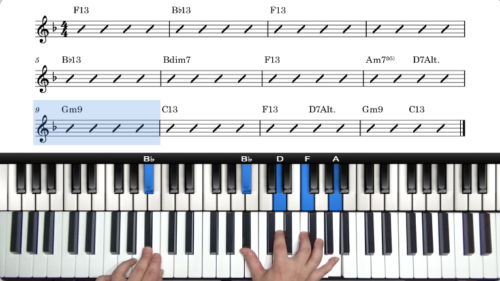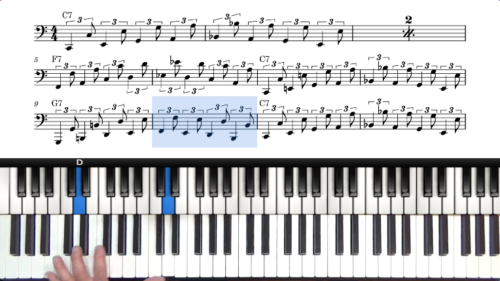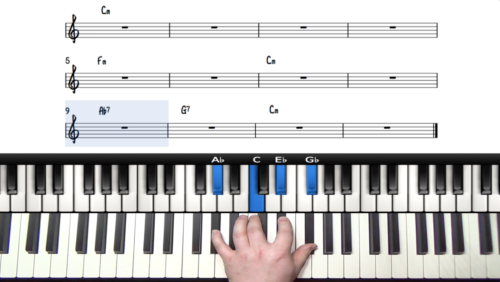Blues Left Hand Shuffle Patterns
Welcome to lesson 3 in this course on Chicago Blues Piano. We are now going to shift the focus onto our left hand and explore some useful left hand shuffle patterns and some groovy single note basslines.
We will also cover straight 8th note left hand patterns, but the majority of this lesson will focus on the blues shuffle feel, also known as the triplet 8th note feel.
How to Play a Blues Shuffle
We start by playing the blues shuffle pattern based around a 5th and 6th interval in our left hand. This is one of the most useful patterns to learn because of its simplicity.
It creates both a solid groove, and also harmonic interest at the same time. The 5th interval is unique because it can be played in the lower registers of the piano without it sounding “muddy”.
When working on our hand independence, we must train our left hand to play this rhythm almost subconsciously which frees up our right hand for melodic creativity.
Straight 8ths vs. Shuffle
We can also play the same pattern with straight 8ths. We are using the exact same notes but this gives us a completely different feel.
In terms of ‘swing’, there is a lot of space in-between straight and shuffle. We can choose where to place our 8th notes to get many different types of feel.
Left Hand Shuffle Variations
In this lesson we cover many variations of this simple left hand pattern. Once the basic pattern has been internalised, Steve demonstrates the following variations:
- extending the pattern up the the b7
- adding the b3 to the major 3 then and the 5th and 6th
- playing just the 5th with the b3 to major 3rd
- ‘rolling’ the notes to create many other variations.
Single Note Walking Basslines
Another kind of basslines is the single note walking bassline. The easiest way to construct a single note bassline is to use the arpeggio based on the root, 3rd, 5th and 6th of each chord.
Steve demonstrates multiple choruses with arpeggio basslines, then adds in scalar passages for interest and variety, and finally he demonstrates how to incorporate the b7th into the basslines.
The full transcription of Steve’s walking basslines can be downloaded below.
Lesson Downloads
-
Left Hand Shuffle Patterns PDF File Type: pdf
-
Single Note Bassline Patterns File Type: pdf
Practice Tips
-
A 5th interval is a very powerful sound which creates a very solid harmonic foundation for the song. This is why the 5th is so effective for blues basslines.
-
The 5th could be likened to the biggest stone block in the foundation of a building.
-
If we play a 3 note chord in the lower registers it can sound "muddy".
-
The 2 notes of the 5th interval will always give you a big, fat, solid sound in the bass while keeping the sound clear and crisp.








When we talk about these “inner movements” – is this a form of superimposition. In other words when you move to the IV chord “within” the I chord, is this therefore treated as playing the 4,7 and 9 of the I chord – creating a sus sound of I chord rather than moving to a new chord?
To rephrase the question – should we be thinking of these as changing quickly to IV passing chords, or as superimposed IV chords as part of larger overall I chord.
I hope the question makes sense – this question has come up over and over again in various form over the last few years!
Thanks,
Jamie
Hi Jamie 👋🏻
Good question!
My preferred way to look at this would be “changing quickly to IV passing chords”.
The I and the IV chord are a 5th apart, and so they are closely related.
They naturally gravitate towards each other and so we are simply utilising this to add more interest and movement to an otherwise static harmony.
Let me know if you have any further questions and enjoy the lessons!
Cheers,
Hayden
Any tips for how to prevent your forearm seizing up when your playing these patterns? I find mine becomes tense and painful
Hi Brian 👋🏻
Apologies for the delay here, this comment slipped down my inbox.
Check out this recent forum thread where Tuomo gives his advice on correct posture whilst at the piano: pianogroove.com/community/t/what-are-you-working-on-in-quarantine/4247/5 – first and foremost, make sure you are not playing with an awkward posture.
Also understand that the Chicago Blues and Boogie Woogie style is very intensive on the left hand forearm. If you are new to the style it may take some time to build up your strength and endurance. My recommendation would be to gradually work on your strength, if you feel your forearms starting to seize up then take a break immediately, or perhaps come back to it the next day.
With time your endurance will increase and the left hand style will become less of an effort.
I hope this helps Brian and be sure to check out the forum post above.
Cheers,
Hayden
In the last part of the lesson “single notes” the term “scalar connections” is used.
What does it mean? Do you just “walk” up every key chromatically or still within the diatonic notes?
Thanks for any suggestion!
Hi Sebastian,
Great question!
Looking at Steve’s demonstrations, he adds 1 chromatic tone into his ‘scale bass lines connections’.
At 8:27 – over the C7 chord he walks up C-D-Eb-E to land on F (the root of the IV chord) in the 5th bar. Here the note Eb is the chromatic passing tone. Eb is not one of the C7 chord tones and so we can view this as a chromatic passing tone. This adds a little tension between the 2nd and 3rd notes of the scale, and it ensures that we land cleanly on the note F in the 5th bar via a half step interval from E to F.
At 8:33 – over the C7 chord, he walks down C-Bb-A-Ab to land on G which is the root of the V chord in bar 9. In this example the note Ab is the chromatic passing tone and the other notes are part of the C7 scale also known as the C mixolydian mode.
In both examples, he uses 2 chord tones (either root, 3rd, 5th, 6th or 7th) and 1 chromatic passing tone which is not part of the scale. Both examples are walking up or down the scale and adding 1 chromatic passing tone.
Again in the second example you will see that the chromatic passing tone allows Steve to land on the note G (the root of the V chord) via a half step approach and this creates a very clean and connected sound in the bass line.
Here are some other walking bass line lessons which you should find useful:
community.pianogroove.com/t/walking-bass-line-tutorials-for-jazz-blues-piano/3305
I created this forum thread which links to many different walking bass line lessons by myself and our other teachers.
I hope that helps Sebastian – and have fun practicing this stuff!
Cheers,
Hayden